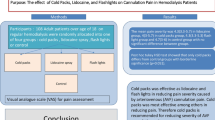Abstract
Objective: To observe the clinical efficacy of auricular point sticking at different points to relieve the pain in arteriovenous fistula puncture.
Methods: A total of 42 patients with arteriovenous fistula were randomized into a Shenmen (TF4) group and an Elbow (SF3) group by the random number table method, with 21 cases in each group. After enrolled into different groups, before the dialysis, patients were given auricular point sticking with Wang Bu Liu Xing (Semen Vaccariae) seeds at Shenmen (TF4) and Elbow (SF3), respectively. Patients were asked to press the seeds themselves for 2 min each time, four times a day, and an additional 5-15 min before the arteriovenous fistula puncture. Intensive pressing was offered during the puncture, 15-20 presses for each time, and the plasters were changed every 2-3 d. The numerical rating scale (NRS) was used to score the pain level one week before and after auricular point sticking. The NRS score was then compared and analyzed.
Results: The intra-group comparison showed that the changes of NRS score in both groups were statistically significant after auricular point sticking (both P<0.05). After the treatment, there was no significant difference in NRS score between the two groups (P>0.05).
Conclusion: Auricular point sticking at Shenmen (TF4) or Elbow (SF3) can effectively relieve the pain of arteriovenous fistula puncture, and these two points have equivalent analgesic effect.
摘要
目的: 观察耳穴贴压不同穴位缓解动静脉内瘘血管穿刺疼痛的疗效。
方法: 采用随机数字表法将42 例 动静脉内瘘患者分为神门穴组和肘穴组, 每组21 例, 于入组后透析前分别将王不留行籽贴压于耳神门穴和肘穴。 患者每日自行按压4 次, 每次按压2 min, 并于动静脉内瘘血管穿刺前5-15 min 增加按压1 次, 穿刺同时加强按压, 每次按压15-20 次, 2-3 天更换1 次。使用数字评定量表(NRS)记录每例患者耳穴贴压前1 周内和耳穴贴压后1 周 内的疼痛评分, 并对NRS 评分进行比较分析。
结果: 组内比较, 耳穴贴压后两组NRS 评分变化均有统计学意义(均 P<0.05)。治疗后, 两组NRS 评分无统计学差异(P>0.05)。
结论: 耳穴贴压神门穴或肘穴均能有效减轻动静脉内 瘘血管穿刺疼痛; 神门穴与肘穴的镇痛效果相当。
Similar content being viewed by others
References
Zhang JC, Al-Jaishi AA, Na Y, de Sa E, Moist LM. Association between vascular access type and patient mortality among elderly patients on hemodialysis in Canada. Hemodial Int, 2014, 18(3): 616–624.
Amedia CA Jr, Bolton WK, Cordray T, Hakim R, Howard R, Jackson J, Kulawik D, Lyon M, Mahoney D, Messana A, Nissenson A, Oviatt L, Parlato D, Roddy S, Solid C. Vascular access for HD: aligning payment with quality. Semin Dial, 2011, 24(1): 37–40.
Mei CL, Gao X, Ye Z Y. Practical Dialysis Handbook. 3rd Edition. Beijing: People’s Medical Publishing House, 2017.
He ZL, Cai BL, Zen JH. Observation on effect of psychological nursing combined with ear point pressure beans to alleviate anxiety in early dialysis patients. Huli Yanjiu, 2016, 30(9): 3443–3445.
Cheng HX. Observation of seeds buried at auricular point for the postoperative analgesia in the department of orthopaedics. Linchuang Yanjiu, 2017, 25(5): 167, 170.
Shan ZX. Observation of seeds buried at auricular point for the uterine contraction pain after cesarean section. Yixue Xinxi, 2014, (37): 409.
Zhong LY, Zou YH. Observation of seeds buried at auricular point for the postoperative analgesia in the fistulation. Yiyao Qianyan, 2017, 7(2): 242–243.
Xu GH, Liu H. Foundation of Traditional Chinese Medicine Nursing. 2nd Edition. Beijing: China Press of Traditional Chinese Medicine, 2012: 465–470.
Macintyre PE, Walker S, Power I, Schug SA. Acute Pain Management: Scientific Evidence. 3rd Edition. Melbourne: Australian and New Zealand College of Anaesthetists, 2010: 39.
Liu XH, Shan Y, Shi QY. Research status of arteriovenous fistula pain in hemodialysis patients. Zhonghua Huli Zazhi, 2013, 48(11): 1045–1047.
Xu J, Liu S, Yan J, Wang LF. Analysis of the correlated factors of puncture-related pain in patients with the arteriovenous fistula undergoing maintenance hemodialysis. Zhongguo Shiyong Huli Zazhi, 2015, 31(25): 1885–1889.
Wu XQ, Zhong ZC, Fang KY. Nursing effect of lidocaine surface anesthesia on arteriovenous fistula pain in hemodialysis patients. Guangdong Yixue, 2013, 34(18): 2902–2903.
Jin YX, Zhang X, Wu YQ. Chinese literature analysis of 84 cases anaphylactic shock induced by lidocaine injection. Yaowu Liuxingbingxue Zazhi, 2014, 23(5): 329–331.
Li SL, Gan XQ, Liu S. One case of gastrointestinal allergy caused by lidocaine plasmagel. Chongqing Yixue, 2014, 43(14): 1824.
Huang LC. Auricular Acupoint Diagnosis. 2nd Edition. Beijing: Scientific and Technical Documentation Press, 2017.
Zheng HX. Basic Theory of Traditional Chinese Medicine. Beijing: China Press of Traditional Chinese Medicine, 2016.
Liu XX, Wang X. Efficacy observation on acupuncture combined with auricular point sticking treatment for primary dysmenorrhea. J Acupunct Tuina Sci, 2013, 11(4): 262–264.
Si JL, Yang MQ, Sima LJ, Han XC, Ren YY. Analgesic effect of transcutaneous electrical stimulation at the auricular Shenmen (TF4) point after total knee arthroplasty. Zhongguo Zuzhi Gongcheng Yanjiu, 2017, 21(27): 4294–4299.
Mei SJ, Yu J. Effect of auricular points sticking on decreasing anxiety and pain for patients undergoing PICC by ultrasound-guided. Zhonghua Xiandai Huli Zazhi, 2015, 21(15): 1780–1782.
Fan XY, Liu YP, Xie JH, Chen YS, Cao YY. Clinical research of vasospasm and vagus reflex during radial artery puncture treated with auricular point sticking. Zhongguo Zhen Jiu, 2018, 38(2): 137–140.
Lin HF. Practical Blood Purification Care. 2nd Edition. Shanghai: Shanghai Science and Technology Publishing and Distribution Co., Ltd., 2015.
Chen H, Duan BF, Yang JS, Yan PH, Wang YY. Discussion of the influencing factors of acupoint effect. Guangzhou Zhongyiyao Daxue Xuebao, 2017, 34(3): 458–461.
Cao Y, Wang YQ. Acute lumbar sprain treated with massage combined with acupuncture at different distal acupoints: a randomized controlled trial. Zhongguo Zhen Jiu, 2015, 35(5): 453–457.
Wang Y. The role of nurses in pain management. Jiankang Bidu, 2013, 12(10): 383–384.
Acknowledgments
This work was supported by the Project of Science and Technology Department of Zhejiang Province (浙江省科技 厅项目, No. 2016ZQ028).
Author information
Authors and Affiliations
Corresponding author
Additional information
Conflict of Interest
The authors declared that there was no potential conflict of interest in this article
Statement of Informed Consent
Informed consent was obtained from the patients in this study.
Rights and permissions
About this article
Cite this article
Liu, Gm., Lin, Ry., Lu, Xy. et al. Auricular point sticking for relieving pain in arteriovenous fistula puncture. J. Acupunct. Tuina. Sci. 17, 427–431 (2019). https://doi.org/10.1007/s11726-019-1145-4
Received:
Accepted:
Published:
Issue Date:
DOI: https://doi.org/10.1007/s11726-019-1145-4
Keywords
- Auricular Point Sticking
- Otopoint
- Elbow (SF3)
- Otopoint
- Shenmen (TF4)
- Arteriovenous Fistula
- Pain Measurement
- Hemodialysis




